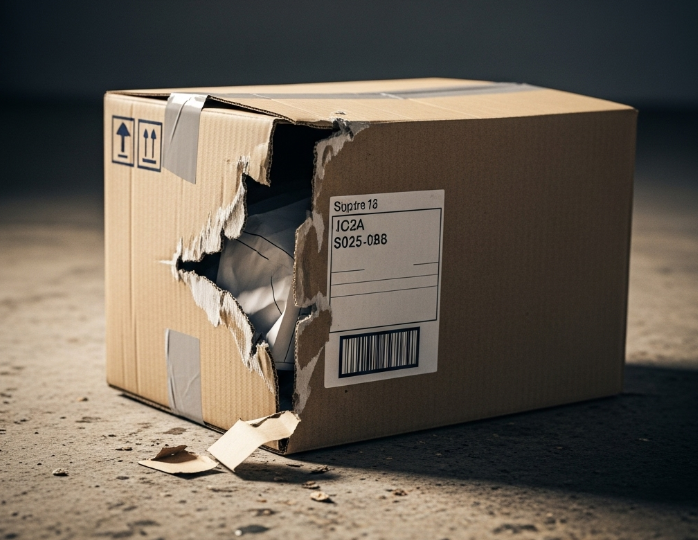The aerospace and aviation industry stands as a monumental testament to human ambition and precision. From the intricate systems of a satellite orbiting Earth to the colossal engines propelling commercial airliners, every component represents an astonishing investment in engineering, materials, and specialized labor. Yet, these marvels of technology, often valued in the millions or even billions of dollars, embark on journeys through complex global supply chains that are rife with unseen perils.
Are you truly aware of the myriad dangers your invaluable aerospace shipments face from the moment they leave the factory floor until they reach their final destination? It’s not enough to rely on careful handling or the mere hope of a smooth journey. The inherent risks in moving ultra-high-value, mission-critical components across continents demand a fundamental safety net. This blog post will shed light on aerospace shipping insurance, not as a commodity, but as an indispensable strategic tool that provides a critical layer of protection against the unpredictable nature of global logistics. Understanding these risks is the first step toward safeguarding your most vital assets.

The Astonishing Value of Aerospace Cargo
To truly grasp the necessity of robust protection, one must first comprehend the sheer scale of investment encapsulated within every aerospace shipment. This isn’t just about monetary value; it’s about the culmination of cutting-edge research, meticulous design, and highly specialized manufacturing processes.
From Microchips to Megastructures: A Spectrum of Immeasurable Value
The diversity of aerospace cargo is staggering. It ranges from tiny, highly sensitive microchips and avionics systems, which, despite their size, can cost hundreds of thousands of dollars due to their complexity and proprietary technology, to massive structural components like fuselage sections, wing assemblies, or landing gear. At the apex are complete aircraft engines, which can be valued between $10 million and $60 million each, depending on the model and specifications.
The global Aircraft Component Market alone was valued at approximately $956.5 Billion in 2024, projected to reach an astounding $1,599.5 Billion by 2034. This exponential growth underscores the ever-increasing stakes involved in every shipment. Losing or damaging even a single high-value component can equate to losing a significant portion of a company’s annual revenue or a critical investment.
Beyond the Price Tag: The True Cost of Downtime & Delays
While the financial value of aerospace components is immense, the cost of their loss or damage extends far beyond a simple replacement fee. In the aerospace sector, delays and downtime translate directly into colossal operational and reputational damage:
- Aircraft on Ground (AOG) Situations: An AOG event, where an aircraft is unable to fly due to a maintenance issue, can cost airlines anywhere from $10,000 to $150,000 per hour, depending on the aircraft type and route. If a critical replacement part is delayed or damaged in transit, these costs skyrocket, leading to significant revenue loss, passenger disruption, and damaged brand reputation.
- Production Halts: For manufacturers, a missing or damaged component can bring an entire assembly line to a grinding halt. Given the tight schedules and high demand (Airbus and Boeing had a backlog of over 14,000 aircraft by the end of 2024), such delays can incur massive contractual penalties and push back delivery dates to waiting customers for years, impacting future orders.
- Contractual Penalties & Legal Disputes: Delays or inability to fulfill orders due to damaged shipments can trigger severe contractual penalties, liquidated damages, and even lead to costly legal disputes with clients and suppliers.
- Reputational Damage: Consistently delayed or damaged shipments can erode trust with customers, partners, and even regulatory bodies. In an industry where reliability is paramount, a compromised reputation can have long-lasting negative impacts on a company’s market position and ability to secure future contracts.
- Increased Operating Costs: Beyond direct replacement, damaged goods lead to increased operating costs from expediting new shipments, rework, additional personnel to manage returns and replacements, and potential increases in future insurance premiums.
These hidden costs emphasize that protecting the physical asset is merely one layer of risk management; safeguarding operational continuity and financial stability is equally vital.
Unseen Perils: 7 Critical Risks That Demand Aerospace Shipping Insurance
Despite meticulous planning and advanced logistics, aerospace shipments navigate a world full of unpredictable variables. Understanding these pervasive risks is the first step in appreciating the fundamental need for aerospace shipping insurance.
1. Accidental Damage in Transit: The Unexpected Impact
Even with the most careful handling, the sheer distances and numerous touchpoints in global logistics expose aerospace cargo to constant threats of accidental damage. This isn’t always about outright negligence but the cumulative effect of transit.
- Rough Handling: Despite best efforts, packages can be dropped, stacked improperly, or mishandled during loading, unloading, or transfer between transport modes.
- Vibration & Shock: Prolonged vibrations during air or ground transport, or sudden jolts, can cause internal damage to sensitive electronics, mechanical components, or structural fatigue in composite materials that might not be immediately visible.
- Collisions & Accidents: Road accidents involving trucks carrying aerospace cargo, or even minor incidents at air cargo terminals, can lead to significant damage.
Even minor impacts can result in costly rework or product loss, especially in precision engineering where tolerances are extremely tight.
2. Theft & Pilferage of High-Value Components
Aerospace components, particularly those that are small, high-tech, and carry immense value, are attractive targets for organized theft. The black market for aircraft parts, though regulated, exists, and sophisticated criminals are always looking for opportunities.
- Targeted Theft: High-value avionics, specialized metals, or unique manufacturing tools can be specifically targeted by criminal networks with knowledge of their value and potential resale.
- Opportunistic Pilferage: Less sophisticated theft can occur during storage at unsecured facilities or during transfers, where smaller, valuable items might be siphoned off.
- Cyber-Enabled Theft: While not physical, sophisticated cyberattacks can disrupt supply chain visibility, creating windows of opportunity for physical theft by obscuring tracking data or diverting shipments.
These incidents not only result in direct financial loss but can also introduce unapproved parts into the supply chain, posing significant safety risks.
3. Environmental Extremes & Contamination
Aerospace components are often designed to operate within strict environmental parameters. Their journey through the supply chain can expose them to conditions far outside these tolerances, leading to degradation or contamination.
- Temperature Fluctuations: Extreme heat or cold can degrade sensitive materials, electronic components, lubricants, or adhesives. Shipments passing through diverse climates (e.g., desert to arctic) are particularly vulnerable.
- Humidity & Moisture: Exposure to high humidity or direct water (from leaks, rain, or even condensation) can cause corrosion, short circuits in electronics, or material degradation.
- Dust & Contamination: Fine dust, debris, or chemical contaminants in storage facilities or during open transit can compromise precision instruments, optical components, or hydraulic systems, requiring extensive cleaning or rendering parts unusable.
Maintaining specific environmental controls throughout a complex global journey is a significant challenge, and deviations can lead to silent, insidious damage.
4. Natural Disasters & Acts of God
Even the most meticulously planned logistics can be upended by forces of nature, often referred to as “Acts of God” in insurance terms. These events are unpredictable and can lead to widespread, catastrophic losses.
- Severe Weather: Hurricanes, blizzards, tornadoes, and floods can cause extensive damage to warehouses, ground transport, or force flight cancellations and port closures, delaying or destroying cargo.
- Earthquakes & Tsunamis: These geological events can devastate infrastructure, warehouses, and transport networks, trapping or destroying shipments.
- Wildfires: Increasingly prevalent, wildfires can threaten storage facilities and ground transport routes, leading to direct loss or forced rerouting and delays.
In such scenarios, standard carrier liability often offers no recourse, as these events are typically excluded from their basic coverage.
5. Geopolitical Instability & Customs Delays
The global aerospace supply chain is highly susceptible to geopolitical shifts, trade disputes, and bureaucratic hurdles that can cause significant disruptions and unforeseen risks.
- Trade Wars & Tariffs: Sudden imposition of tariffs or trade restrictions can cause components to be held indefinitely at borders, incurring storage costs or even forcing their return.
- Customs Delays & Errors: Even minor inaccuracies in documentation, new import/export regulations, or heightened security screenings can lead to prolonged customs holds. During these holds, cargo may be exposed to less secure environments, temperature fluctuations, or mishandling.
- Political Unrest & Conflict Zones: Shipments rerouted through or near politically unstable regions, or areas affected by conflict, face increased risks of theft, damage, or seizure, leading to complete loss. The war in Ukraine, for example, highlighted how quickly established routes can become unviable.
- Sanctions & Embargoes: New international sanctions or embargoes can suddenly render a shipment illegal, leading to its confiscation or permanent detention.
These external pressures often fall outside the control of either the shipper or the carrier, yet their impact on aerospace cargo can be devastating.
6. Errors in Documentation & Handling
Human error, though unavoidable, can introduce significant risks into the aerospace supply chain, leading to delays, misdirection, or even damage to cargo.
- Mislabeling & Misrouting: Incorrect addresses, labels, or manifest errors can lead to shipments being sent to the wrong destination, causing significant delays and potential exposure to additional risks during rerouting.
- Improper Packaging: Inadequate internal cushioning, external containers not suited for the item’s weight/fragility, or failure to secure cargo properly within a transport vehicle can directly lead to damage during transit.
- Incorrect Classification: Misclassifying dangerous goods or high-value items on shipping documents can lead to customs holds, fines, or even unsafe handling by unaware personnel.
- Administrative Oversight: Missing permits, licenses, or customs declarations can result in prolonged delays at borders, exposing cargo to risks in less controlled environments.
While many of these can be mitigated with meticulous internal processes, they remain pervasive risks that demand a safety net for when they occur.
7. Fire & Explosion
Though less common for individual packages, the risk of fire or explosion in warehouses, on transport vehicles, or at cargo hubs is a significant concern for high-value concentrations of goods.
- Facility Fires: Fires at large logistics hubs or warehouses, even if unrelated to your specific cargo, can result in total loss for all goods stored within. Factory fires, in particular, have been a leading supply chain disruption across all industries for several consecutive years.
- Vehicle Fires: Fires originating from vehicle malfunctions, collisions, or flammable materials within multi-cargo containers can destroy shipments.
- Battery Fires: With the increasing use of lithium-ion batteries in various aerospace components, the risk of battery-related fires during transit or storage, though rare, is a serious concern.
These catastrophic events often result in complete loss of cargo and are typically excluded from standard carrier liability, highlighting the need for comprehensive protection.
Why Traditional Solutions Fall Short
Given the immense value and critical nature of aerospace components, relying on traditional or minimal forms of protection is akin to flying a multi-million dollar aircraft with only a flimsy umbrella as a parachute. For the sophisticated demands of the aerospace industry, common “solutions” simply don’t cut it.

Carrier Liability: A Minimal Lifeline
Many businesses mistakenly believe that the liability coverage provided by their shipping carrier is sufficient. This is a dangerous misconception, particularly for aerospace shipping insurance. As discussed, carrier liability is a minimal lifeline at best:
- Low Limits, Not Full Value: Carriers typically limit their liability to a very small amount per pound or per package, which is catastrophically inadequate for aerospace components. For instance, an engine worth millions might only be covered for a few thousand dollars. This isn’t “insurance” for your asset’s true value; it’s a minimal gesture.
- “Proven Negligence” Clause: Carriers are usually only liable if their own negligence can be proven to have caused the loss or damage. This means if a natural disaster strikes, or if theft occurs despite their security measures, or if an item is damaged by another shipper’s poorly packed cargo, you’re often out of luck. The burden of proof also lies heavily on the shipper, leading to prolonged and often unsuccessful claims processes.
- Exclusions Galore: Carrier liability often comes with numerous exclusions, including “Acts of God,” delays, war, political risks, improper packaging (even if done by a third party), and inherent vice (the nature of the good itself being prone to damage). These exclusions cover many of the key risks aerospace cargo faces.
The Illusion of “Self-Insurance” for High-Value Goods
Some large corporations might consider “self-insuring” their high-value shipments, believing they can absorb any potential losses. While feasible for some industries with high volume and low-value goods, this is rarely a viable or prudent strategy for aerospace:
- Catastrophic Impact: A single loss of a multi-million dollar aerospace component can create a financial hole so large that it negates any accumulated “savings” from self-insurance over years, potentially jeopardizing the entire company’s financial stability.
- Unpredictable Frequency: While individual losses might be rare, their occurrence is unpredictable. A large loss can hit at any time, often when least expected or during periods of financial strain.
- Missed Opportunities: The capital held in reserve for self-insurance could otherwise be invested in R&D, production expansion, or market penetration, limiting growth potential.
- Operational Disruption: Self-insurance does not expedite the replacement of a lost item or mitigate the operational impact. The company still bears the full brunt of sourcing, manufacturing, and shipping a replacement, along with all associated delays and penalties.
For the unparalleled value and criticality of aerospace components, proactive aerospace shipping insurance offers a level of protection and peace of mind that self-insurance cannot.
The Fundamental Role of Aerospace Shipping Insurance
Understanding the diverse and substantial risks that aerospace shipments face reveals the critical, often understated, role of comprehensive aerospace shipping insurance. It’s far more than a contingency plan; it’s a foundational element of sound aerospace logistics and risk management.
More Than Just a Policy: A Strategic Risk Management Tool
In the high-stakes world of aerospace, insurance transcends its basic function as a financial safeguard. It serves as a strategic risk management tool, enabling proactive decision-making and bolstering overall operational resilience. By transferring the financial risk of loss or damage to an insurer, businesses can mitigate a vast array of unforeseen liabilities. This allows companies to:
- Maintain Financial Stability: Prevent single incidents from derailing budgets, impacting cash flow, or necessitating emergency funding.
- Focus on Core Operations: Free up internal resources from managing potential claims or assessing hidden risks, allowing teams to concentrate on innovation, production efficiency, and customer satisfaction.
- Enhance Credibility: Demonstrate to customers, investors, and regulatory bodies a commitment to robust risk management, fostering trust and reinforcing the company’s reputation for reliability.
- Facilitate Global Expansion: Venture into new markets or expand supply chains with greater confidence, knowing that the inherent risks of international transport are financially covered.
Protecting Your Investment: Peace of Mind for Critical Shipments
Ultimately, the most profound benefit of aerospace shipping insurance is the peace of mind it provides. For components that are literally worth millions and critical to the very functionality of an aircraft, this peace of mind is invaluable. It means:
- Confidence in Transit: Knowing that whether your shipment encounters a sudden storm, an unforeseen customs delay, or an accidental impact, its financial value is secured.
- Swift Recovery: In the event of a loss, a specialized insurance policy ensures a clear, expedited path to financial recovery, allowing for faster replacement of parts and minimal interruption to your operations.
- Uninterrupted Progress: Aerospace projects often span years, involving complex timelines and interdependencies. Having reliable insurance ensures that a shipping mishap doesn’t unravel months or years of planning and investment.
This peace of mind allows aerospace professionals to focus on what they do best: innovating, manufacturing, and maintaining the aircraft that connect our world and explore our skies.

Conclusion
The aerospace and aviation industry operates on the cutting edge of technology, but its supply chain remains vulnerable to a myriad of risks – from the unpredictable fury of nature to the subtle dangers of handling errors. Every high-value component, every critical shipment, carries not just an immense financial burden but also the weight of operational continuity and reputation. Relying on minimal carrier liability or attempting to self-insure against these multi-million dollar perils is a gamble no aerospace enterprise can afford to take.
Understanding these inherent risks – accidental damage, theft, environmental extremes, geopolitical instability, documentation errors, and catastrophic events – is the crucial first step. The second is to recognize that robust aerospace shipping insurance is not an option, but a fundamental requirement for strategic risk management. It provides comprehensive financial protection, tailored coverage for unique aerospace challenges, and the invaluable peace of mind that allows you to focus on your core mission.
To learn more about how comprehensive aerospace shipping insurance can safeguard your invaluable assets and bolster your supply chain resilience, explore resources dedicated to protecting high-value cargo. Click here to visit ShipSimple.
Additional Resources
- Shipping Insurance Overview
- Aerospace & Aviation Industry Page
- Get a Quote
- Shipping Insurance FAQs
- Freight Insurance for Electronics
- Aviation Week – Supply Chain Risk
- IATA Guidelines for Shipping Aircraft Parts
- Transport Canada – Aerospace Regulations
- Boeing’s Global Supply Chain Strategy
- ICAO Logistics & Cargo Programs
- UPS Aerospace Logistics Solutions





